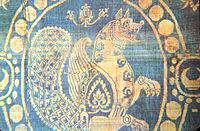Simurgh

The Simorgh (Persian: سيمرغ ), Pahlavi (Middle Persian) Senmurv, Sēnmurw (and earlier Sēnmuruγ), also known in Pāzand as Sīna-Mrū, is a fabulous, mythical bird in Persian mythology. It also appears in medieval Armenian and Byzantine art. Sometimes it is referred to as a Roc.
Etymology
The name derives from Avestan mərəγō Saēnō "the bird Saēna", originally a raptor, likely an eagle, falcon or sparrowhawk, as can be deduced from the etymologically identical Sanskrit śyenaḥ, who also appears as a divine character. Saēna is also attested as a personal name which is derived from the bird name.
The first element has been connected in folk etymology to Modern Persian si "thirty", but it is not historically related. In English, Simurgh can be translated to mean Phoenix.
Mythology
The mythical Simurgh or Simorgh is depicted in Iranian art as a winged creature in the shape of a bird gigantic enough to carry off an elephant or a whale. It appears as a kind of peacock with the head of a dog and the claws of a lion; sometimes it is shown with a human face. The Simorgh was also called Siræng "Thirty Colors" because it is thought to have thirty different colors on its body, making it quite beautiful.
Because it is part mammal, the Simorgh suckled its young - and also has teeth. It has an enmity towards snakes and its natural habitat is a place with plenty of water. According to the twelfth-century poet Attar, the Simorgh has thirty holes in her beak and flew the wind through them whenever she was hungry. Animals heard a pretty music and gathered at the peak of mountain where they were eaten by the Simorgh.
In one ancient Iranian account, the Simorgh was said to live 1700 years before plunging itself into flames (compare the phoenix); in later accounts, it is immortal and is said to have a nest in the Tree of Knowledge.
According to Iranian legend, it is said that this bird is so old that it has seen the destruction of the world three times over. Simorgh learned so much by living that long that it is thought to possess the knowledge of all ages.
Sassanid Persians believed the Sēnmurw would bestow fertility upon the land and the union between the earth and the sky. It roosted in the tree of life, Gaokerena, and lived in the land of the sacred Haōma plant, whose seeds could cure all evil. In later Iranian lore, the Simorgh became a symbol of divinity. Sēnmurw/Simorgh is also identified as Homā in Persian literature and in Arabic introduced as the Rukh (the origin of the English word "Roc").
When the Simorgh took flight, the tree of knowledge's leaves shook making all the seeds of every plant to fall out. These seeds floated around the world, taking root to become every type of plant that ever lived, and curing all the illnesses of mankind. Its feathers are said to be the color of copper, and though it was originally described as being a Dog-Bird, later it was shown with either the head of a man or a dog. It is inherently benevolent and a touch from its wings can cure any illness or wound.
Later Arab nations used the legend of Simorgh to take their own mythical creature, named Ghoghnus.
Simorgh in the Shahnameh
The Simorgh made its most famous appearance in the Ferdowsi's epic Shahname (Book of Kings), where its involvement with the Prince Zal is written. According to the Shahname, Zal, the son of Saam, was born albino. When Saam saw his albino son, he assumed that the child was the spawn of devils, and abandoned the infant on the mountain Alborz.
The child's cries were carried to the ears of the tender-hearted Simorgh, who lived on top this peak, and she retrieved the child and raised him as her own. Zal was taught much wisdom from the loving Simorgh, who has all knowledge, but the time came when he grew into a man and yearned to rejoin the world of men. Though the Simorgh was terribly saddened, she gifted him with a single golden feather which he was to burn if he ever needed her assistance.
Upon returning to his kingdom, Zal fell in love and married the beautiful Rudaba. When it came time for their son to be born, the labor was prolonged and terrible. Zal was certain that his wife would die in labour. Rudabah was near death when Zal decided to summon the Simurgh. The Simorgh appeared and instructed him upon how to perform a cesarean section thus saving Rudabah and the child, who became one of the greatest Persian heroes, Rostam.
Islamic era
Iranian Sufi poet Farid ud-Din Attar wrote about a band of pilgrim birds in search of a Simorgh in his book The Conference of the Birds.
In modern media

- Simurgh has appeared in Squaresoft's Final Fantasy X and Final Fantasy XI computer games as enemy and notorious enemy respectively.
- Simorgh has also appeared in Piers Anthony's Xanth series, as an immortal and incredibly wise bird.
- Simurgh is the name of the AMP's Rapid Response ship in the anime Silent Mobius
- Simorgh was recently made into a card for the Yu-Gi-Oh! Trading Card Game, as "Simorgh- Bird of Divinity" in the Lord of the Storm structure deck.
- Salman Rushdie based much of his first book "Grimus" on the story of Simurgh.
- In The Neverending Story II: The Next Chapter, Bastian creates a dragon called Simurgh.
- Simurgh is a mech that is found in highly popular japanese video game series; Super Robot Wars. There is an upgraded version called Simurgh Splendid. This unit is later renamed Angelg and given a slightly different design.



